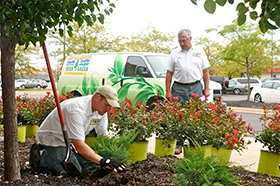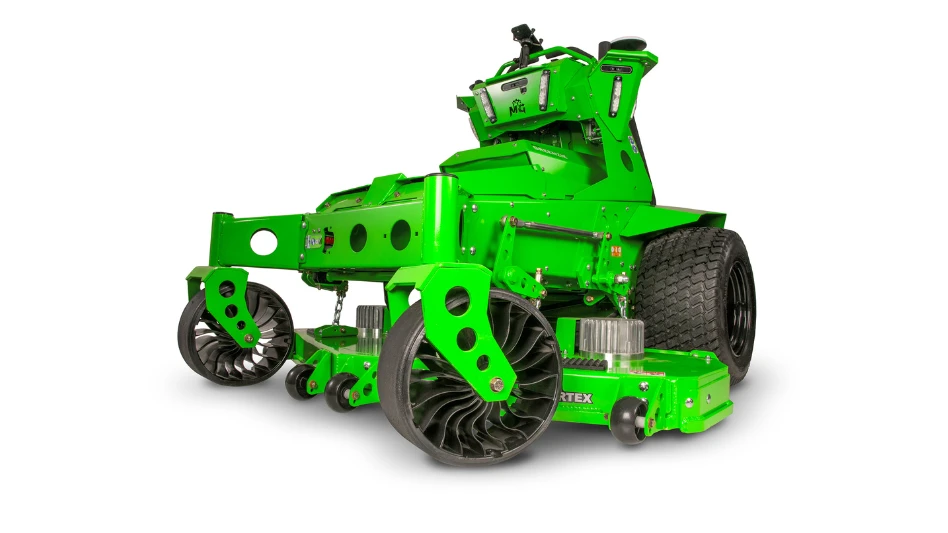
 |
When summer heat sets in, many landscape companies fall back on one tried-and-true strategy: getting an early start.
For JubileeScape, a commercial and residential landscape management company in Mobile, Ala., that means getting to the first job of the day as soon as there is enough light to see by – although employees don’t start on residential projects before 6 a.m., according to president and owner Robin Luce.
Dixie Landscape, a landscape maintenance company that serves homeowners associations and commercial properties in the area surrounding Dade, Fla., also schedules early start times so crews can wrap up the workday sooner on days with particularly high temperatures. And in Troy, Ohio, where Ever-Green Turf and Landscape is located, work starts an hour to an hour and a half earlier when temperatures are forecasted to reach 90 to 95 degrees, says General Manager Kirk Persinger.
But starting the workday early is only one strategy landscape businesses use when the mercury rises. Here are some other key considerations that come into play when the heat settles in for the summer.
Train crews to stay safe. During yearly training, employees of Ever-Green Turf and Landscape learn about the signs of heat exhaustion and dehydration so they know what to look for once summer temperatures arrive. Crew chiefs in particular are on alert for signs of trouble.
“When it’s warm out, I’m in constant contact with my guys,” Persinger says. “Crew chiefs may get tired of hearing from me, but I check in every couple of hours to make sure everything is OK.”
At JubileeScape, supervisors and foremen keep an eye out for employees who look overheated or disoriented. “When we have heat waves, we’ll talk about how we can take care of the guys. It’s about communication,” Luce says. He adds that JubileeScape employees have never dealt with a heat stroke or other serious health problems resulting from heat exposure.
“We have had people get overheated, though,” Luce says. “We’ll send them to the doctor in a moment if they need it. Otherwise, we encourage them to drink plenty of fluids and rest.”
Know when to take breaks. Encouraging rest and fluids are common strategies for helping landscaping crews deal with the heat, but most companies expect employees to take charge of their own safety. “We let the guys and girls manage their bodies themselves. They know their bodies more than we do. If they need two or three breaks before lunch, that’s what they do. I don’t set any schedules,” Persinger says. “When the heat gets like this out there, whenever you need a break or need water, you do what you need to do.”
Jeff Reamer, president of Dixie Landscape, says his company stresses common sense with employees when it comes to extreme heat and Luce agrees. “One size doesn’t fit all. We have reasonable expectations. If someone gets hot, they sit down, take a break, get something to drink. If someone is abusing breaks, that’s a management issue we deal with.”
How frequently employees need breaks also depends on the nature of work they’re doing, Luce adds. For instance, he says employees walking around with backpack sprayers or digging in the dirt for extended periods have to be more cautious in the heat than those riding on a lawn mower.
_ret.jpg) |
Keep crews cool. Although the responsibility for staying safe falls in large part on employees’ shoulders, many companies also take steps to assist crews in the field. For instance, Dixie Landscape makes sure every vehicle has a working air conditioner when temperatures rise.
Luce says his company stocks plenty of water on every truck, which is a priority for Ever-Green Turf and Landscape, too. “We make sure we have 5-gallon coolers in the back of the truck and refill them with ice cold water at lunchtime so crews don’t have to go out of their way to get something cold to drink,” Persinger says.
Adjust to higher temps – or don’t. In Florida, “nature seems to bring the heat on slowly, and we acclimate to it,” Reamer says. “Basically, we follow the flow of nature, so by the time the peak of it comes we’re in shape for it.”
Most employees do get accustomed to working in high temperatures, Luce adds. “It gets pretty darn hot down here. I do have sympathy for those guys, but the heat is a fact of life.”
However, he says some people handle the heat better than others. “If guys just can’t take the heat, they don’t work out,” he admits.
Persinger offers an example to further illustrate this fact. “Last year, we had an employee whose body reacted very badly to the heat once it got about 86 or 87 degrees. He’d come in early and work and take vacation or personal time if temperatures got high,” Persinger says. Eventually, however, the employee decided to take a different job.
Call it a day. What’s considered “too hot” varies from region to region and also depends on what type of job landscape crews are tackling. Yet most companies do have an informal sense of when “hot” becomes “too hot.” When those “too hot” temperatures hit, management may make the decision to call it a day early.
“We don't want these guys working in the heat when it becomes a safety issue and a productivity issue,” Luce says. If it gets too hot, he says they’re better off saying, “Let’s go home and get an early start tomorrow.” Although the goal is to be as productive as possible, at some points, Luce admits his company just has to say, “We’ve done all we can get done today.”
For Ever-Green Turf and Landscape, if temperatures get up to 95 or 96 degrees at noon, the company shuts down for the day. “It’s too hot for employees and the yards – we don't want to damage plants or turf,” Persinger says. In fact, in 2013, Persinger says the whole company shut down for a couple of days due to heat index readings up to 115 degrees.
“That doesn’t happen very often,” Persinger admits. But when extreme heat occurs, it’s smart to get employees out of the sun
 |
Sun protection strategies
When it comes to protecting employees from the sun’s harmful rays and high temperatures, landscape companies often think carefully about clothing requirements.
At JubileeScape in Mobile, Ala., employees wear khaki pants and yellow shirts, purposefully selected because lighter uniform colors minimize the effects of heat. In particularly hot conditions, employees can wear khaki shorts instead of pants. Baseball caps or hats with brims, which shade employees’ faces and help keep them cool, are also allowed.
Dixie Landscape in Dade, Fla., requires employees to wear long-sleeve shirts. “We use clothing as sun protection,” says Dixie Landscape President Jeff Reamer.
Starting this year, Ohio-based Ever-Green Turf and Landscape employees will wear breathable golf polo shirts as part of their company uniform. When temperatures get particularly hot, they will have the option of wearing a cotton company t-shirt instead. In addition, according to General Manager Kirk Persinger, some employees
wear Frogg cooling towels around their necks to keep their body temperatures down. Employees are also allowed to wear hats.
Sunscreen is a different story. Many contractors, such as JubileeScape, leave employees to decide for themselves whether or not they wish to wear sunscreen. “If people use sunscreen, they use it on their own. We don’t provide it,” says Robin Luce, JubileeScape president and owner.
Although Ever-Green Turf and Landscape does not require use of sunscreen either, the company does encourage its use. During safety training procedures at the beginning of the season, Ever-Green employees learn about the consequences of not wearing skin protection. “But we leave it up to the individual,” Persinger says.
Latest from Lawn & Landscape
- Connect, Control & Conserve with Horizon Technical Services
- Use Horizon's Parts Hotline
- How I built a Top 100 company
- Horizon’s Exclusive TurfGro Fertilizer
- Grow your business with mosquito control
- LandCare adds 2 branches in SoCal, promotes Aleman to branch manager
- Spray them away
- PERC helps debut propane direct-injection fuel system at ACT Expo 2025





